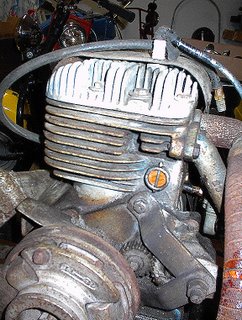Popular Cushman Engines






By far, the most popular engine among Cushman collectors is the 8 horsepower, square block, Husky. This is the engine that came in most Eagles, and the Eagle is the most popular Cushman scooter. The eight horsepower had a three inch bore in a cast iron block. It also had good torque, good speed, and a good sound. Like all Husky engines, it is reasonably easy to repair and many of them have been rebuilt over and over. If it is still running after 50 years or so, it has to be a good engine. A fast engine in the Eagle, it can be a real screamer in a Highlander.
Another favorite is the two-piece, 4 horsepower Husky that was used in the 1940's. All 50-series Cushman scooters came with this engine. If you see a one-piece engine in a 50-series, it is a replacement. The 50-series version of the old two-piece had a 2 5/8 bore in a cast iron block. In good tune it is a smooth-running, good sounding engine, but somewhat slow for today's traffic. The ignition system is weak and unless everything is just right, it will foul spark plugs and build up carbon in the cylinder head. It's easy to spot the two-piece, because the plug is mounted on the front of the cylinder head, horizonal and pointing forward. That makes it easy to remove the plug with a Cresent wrench without danger of chipping the cooling fins on the head.
In the 1960's, Cushman Eagles were available with an aluminum OMC engine. Outboard Marine had taken over the Cushman company and they wanted a more modern engine. That one had overhead valves and 9 horsepower. The cylinder was tilted forward and the outside covers were cast aluminum. It was a very attractive engine. Unlike the Husky, OMC's seldom overheated. Eagles with this engine were called Silver Eagles. The OMC people called it a "Super Husky" but nobody else did. It was easier to just say OMC. A few of the cast iron Huskys came with electric starters, but a much higher percentage of OMC Eagles did. They also had a 12 volt system and carried a rather large battery. This gave Silver Eagles much better lights than older Cushmans.
The 5 horsepower round-block one-piece cast iron Husky, might be called the workhorse of the Cushman line. It was a reliable engine, faster than the two-piece, and easy to maintain. They first appeared in about 1949 in the 60-series. Some were used on Eagles. A 4 horsepower and a 3.2 horsepower version were used in some scooters. The four was the standard engine in Sears Allstate Deluxe model 811.40 in the 50's. It had a 2 5/8 bore. The 3.2 version could be found in the Allstate standard scooters with the model number 811.30 and in some early Highlanders. The 3.2 was not fast enough for most riders and it was often replaced with larger Cushman engines.
A recent trend in Cushman engines is the Briggs Vanguard. They are often seen in Eagles. This is a two-cylinder with at least twice the horsepower of the original engine. Proponents of this engine like the higher horsepower, reliability, looks, and sound, and it certainly helps if you plan to ride in traffic. It is possible to use this engine with a Cushman two-speed transmission, or a modern Comet clutch or torque converter. But like all conversions, it depends on the skill of the person doing the work. A poor conversion can bring problems.
The first few years of Cushman scooters back in the 30's saw the use of 1.5 and 2 horsepower engines. These are prized by collectors but shunned by riders.
